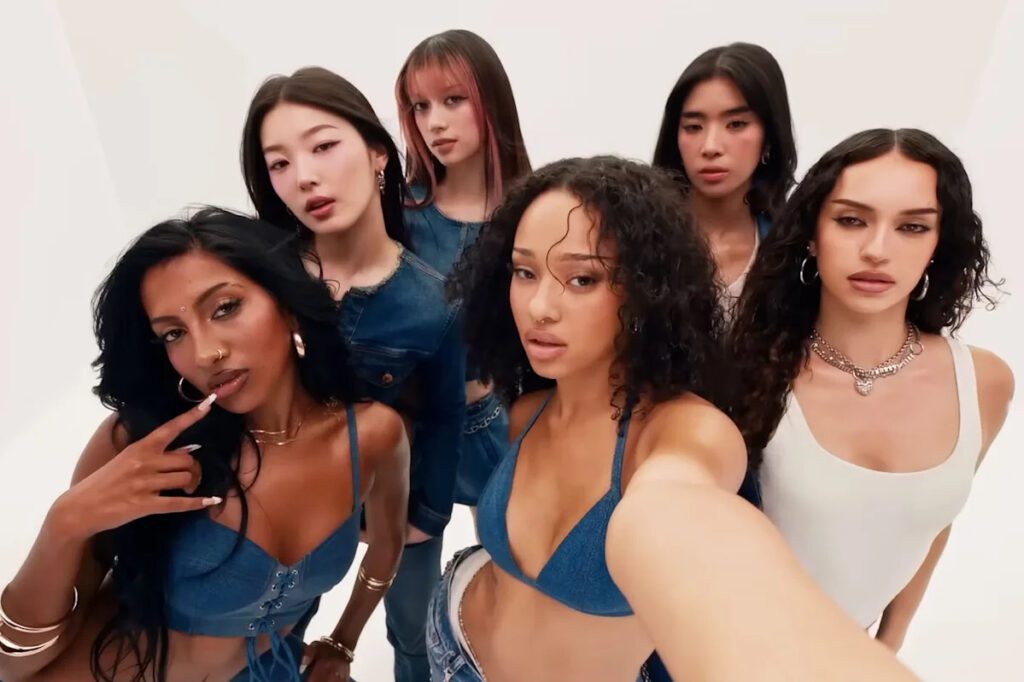A 90-second video starring a handful of beautiful, distinct-looking women in jeans broke the internet, and for once, it wasn’t because of outrage. The Gap ad, which featured the international girl group Katseye performing sharp choreography to Kelis’s nostalgia-inducing 2003 song “Milkshake,” was one of the better-timed ads in history.
“The only ad I intentionally searched,” a YouTube user wrote in the most-liked comment below the video, which earned more than 15 million views in the two weeks since its release and is already being studied in college classes.
Nearly a month earlier, an ad for American Eagle jeans starring Sydney Sweeney incited a massive cultural debate, driving fewer views but more backlash, sparked by the blonde-haired, blue-eyed actress’s sardonic delivery of wordplay about having good genes.
“Genes are passed down from parents to offspring, often determining traits like hair color, personality and even eye color. My jeans are blue,” she says in one commercial.
Critics on the left expressed concern that the ad was promoting eugenics, leading those on the right to defend it. It sent American Eagle stock prices soaring, with the company reporting its campaign with Sweeney was its most successful to date in attracting new customers and driving sales.
It’s impossible not to compare the Katseye ad, with its representation of several races and nationalities, and execution of impressive physical dance moves, to Sweeney’s sultry references to genetic superiority. American Eagle tapped Travis Kelce for another jeans ad after the news of his engagement to Taylor Swift hit timelines — but his bigger life update continued to snatch headlines from the collaboration, making it fall under the radar compared to the other massive jeans-related cultural moments of the last few months.
Though the debate over how jeans are advertised is hitting a fever pitch at the height of the back-to-school and fall shopping seasons, denim has been seen as “cultural currency” for decades, stylist Laura Tully tells Yahoo. Though Gap Inc. didn’t see the same post-ad stock spike that American Eagle did, CEO Richard Dickson said on an earnings call that the Katseye spot’s 8 billion total impressions aided in “reinforcing the cultural relevance of the brand.”
The way companies choose to advertise their jeans shows us “who gets to be seen and how,” Tully says. They’re the one clothing item that transcends class and age, though differing styles can be used to symbolize identity.
The Katseye ad puts the joy of being in a group on display, and the diverse members of the group effectively coincide with the many different styles, fits and washes of jeans available at Gap, trend forecaster Jessica Richards explains. Sweeney’s ad contrasts that: She’s wearing one look and suggesting that she’s the embodiment of good jeans/genes.
When ads endeavor to make jeans represent desire and unattainability — or “good genes” — they “create a tension about who gets to represent authentic American identity and who gets to embody the ‘everyperson’ ideal when they’re literally worn by everyone,” Kendra LaSalle, a style psychology expert, tells Yahoo.
Sweeney’s American Eagle debacle wasn’t the first denim-related ad to stir a moral panic. In 1980, a then-15-year-old Brooke Shields delivered Calvin Klein’s tagline in a TV spot, saying “nothing” comes between her and her Calvins. Like Sweeney, she also mentioned genetics in the ad campaign: “Genes are fundamental in determining the characteristics of an individual and passing on these characteristics to succeeding generations,” Shields says in a commercial.
The ad launched a cultural uproar about how the brand sexualized an underage girl to sell pants, leading to backlash against both the ad and the culture that built up to it.
Denim began as a symbol for the working class in the 1800s, worn by miners and laborers because the fabric is durable and its dark color obscures stains. Through stars like James Dean and Marlon Brando, it became the uniform of a sex symbol in the 1950s, representing freedom and rebellion. Because of their long history as the cornerstone of fashion in the U.S., across trends and even presidential administrations, as candidates for the highest office in the country step out on the campaign trail in jeans, it’s more than just material. Denim has become inherently political.
Now, they’re just something that everybody wears in most settings and situations, from officegoers to Beyoncé. Jeans still feel quintessentially American, even as the country is increasingly divided over what that even means.
“What’s unique is that denim is classless and democratic, yet still coded,” Eleanore Guthrie, a knit denim designer, tells Yahoo. “Everyone owns a pair, but the way you wear them, whether it’s baggy, skinny, ripped [or] low-rise, signals your generation, your politics [and] even your social standing.”
But why do the ways companies sell pants say so much about our culture? They’re an everyday uniform for most people, celebrity stylist Soneca Guadara tells Yahoo.
“They literally shape how we feel about our bodies. You can’t say that about the classic trench coat,” she says. “Almost everyone wears a pair of jeans. It’s personal!”
Actress Sydney Sweeney starred in an American Eagle ad campaign that referenced her “good jeans.” (American Eagle/YouTube)
Even without considering how jeans are sold to people, that’s why finding the right fit and style for you is part of an identity-seeking process that can feel emotional. Fiery debates about jeans pop up all the time. Defending your jeans of choice feels like part of a culture war, even when it’s not technically political.
In the early 2020s, discussions about whether skinny jeans are out-of-date millennial artifacts compared to the superiorly trendy Gen Z-favored flare jeans raised questions about how society reacts to age and the importance of developing personal style amid shifting trends. There have also been plenty of heated conversations about whether high-rise jeans will stick around as low-rise jeans return to popularity, sparking a debate about culture’s changing body image norms.
“Denim is never just denim,” Guadara says. It only took two recent ads to remind us why.

